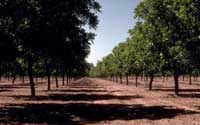Sep 30 2008
Pecan and other hickory woods are the third most popular hardwood group in the United States, behind only black walnut and black cherry. Used in production of beautiful hardwood flooring and furniture, pecan is highly valued for its durability and strength.
 Mature pecan trees
Mature pecan trees
The pruned wood of pecan, a byproduct of forested trees, is usually burned as an economical means of disposal. Increasingly though, pruned pecan is being chipped and incorporated into the soil as an environmentally viable method of handling the waste. Although more expensive than burning, chipping and soil incorporation avoid burning controls recently imposed by many states and the Environmental Protection Agency. To adhere to current EPA regulations, more producers are looking to chipping and incorporation of pruned wood as an alternative to burning. The practice has gained acceptance in many areas of the United States, including the San Joaquin Valley California, where strict environmental regulations have forced growers to adopt alternative ways to deal with waste.
Mohammed B. Tahboub, Department of Soil and Crop Sciences at Texas A&M University, William C. Lindemann, Department of Plant and Environmental Sciences, New Mexico State University, and Leigh Murray, Department of Statistics, Kansas State University, recently published a research study they designed to determine how pecan wood incorporation into the soil would affect soil organic matter content, chemical and physical properties, and whether this practice might present an alternative to burning.
The research study involved incorporating pecan chips into silty clay soil at differing rates. Results indicated that incorporating pecan chips had little effect on soil moisture content, but the soil had an inherently high capacity to hold water. Pecan wood chip incorporation significantly increased soil organic matter content and aggregate stability, particularly at the higher application rates and with repeated amendment. The incorporation of pecan pruning wood into the soil appeared to improve soil tilth and aggregation while providing growers with an environmentally acceptable means of disposal.
The practice may be an environmentally sound solution, but there is a downside. Lindemann observed; "chipping and incorporation (of wood waste) is an alternative to burning, but the practice is expensive. Depending on the size and quantity of wood and the type of self-propelled chipper, the estimated cost for chipping and incorporation in New Mexico is $120-200 per acre, whereas dragging the pruned wood to the end of the field for burning costs $30-50 per acre."
A previous article published in HortScience addressed the nutritional aspects of burning wood chips. Concerns that incorporation of wood chips would tie up nutrients proved not to be the case. According to Lindemann, further research may help refine the practices outlined in the study. He summarized; "the influence of pecan wood chip incorporation must be viewed over several years and with repeated applications for a clear picture of the beneficial and detrimental effects of this disposal method."